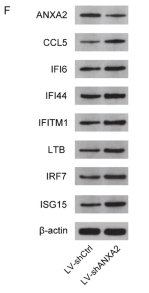ISG15 Antibody - #DF6316
| Product: | ISG15 Antibody |
| Catalog: | DF6316 |
| Description: | Rabbit polyclonal antibody to ISG15 |
| Application: | WB IHC |
| Cited expt.: | WB |
| Reactivity: | Human, Mouse, Rat |
| Prediction: | Pig, Zebrafish, Bovine, Horse, Dog |
| Mol.Wt.: | 18kDa; 18kD(Calculated). |
| Uniprot: | P05161 |
| RRID: | AB_2838282 |
Related Downloads
Protocols
Product Info
*The optimal dilutions should be determined by the end user. For optimal experimental results, antibody reuse is not recommended.
*Tips:
WB: For western blot detection of denatured protein samples. IHC: For immunohistochemical detection of paraffin sections (IHC-p) or frozen sections (IHC-f) of tissue samples. IF/ICC: For immunofluorescence detection of cell samples. ELISA(peptide): For ELISA detection of antigenic peptide.
Cite Format: Affinity Biosciences Cat# DF6316, RRID:AB_2838282.
Fold/Unfold
G1P2; hUCRP; IFI 15; IFI15; Interferon alpha inducible protein; Interferon induced protein 15; Interferon induced protein IFI-15K; Interferon stimulated protein 15 kDa; Interferon, alpha-inducible protein (clone IFI-15K); Interferon-induced 15 kDa protein; Interferon-induced 17 kDa protein; Interferon-induced 17-kDa/15-kDa protein; IP17; ISG 15; ISG15; ISG15 ubiquitin like modifier; ISG15_HUMAN; Ubiquitin cross-reactive protein; Ubiquitin-like protein ISG15; UCRP;
Immunogens
A synthesized peptide derived from human ISG15, corresponding to a region within C-terminal amino acids.
Detected in lymphoid cells, striated and smooth muscle, several epithelia and neurons. Expressed in neutrophils, monocytes and lymphocytes. Enhanced expression seen in pancreatic adenocarcinoma, endometrial cancer, and bladder cancer, as compared to non-cancerous tissue. In bladder cancer, the increase in expression exhibits a striking positive correlation with more advanced stages of the disease.
- P05161 ISG15_HUMAN:
- Protein BLAST With
- NCBI/
- ExPASy/
- Uniprot
MGWDLTVKMLAGNEFQVSLSSSMSVSELKAQITQKIGVHAFQQRLAVHPSGVALQDRVPLASQGLGPGSTVLLVVDKCDEPLSILVRNNKGRSSTYEVRLTQTVAHLKQQVSGLEGVQDDLFWLTFEGKPLEDQLPLGEYGLKPLSTVFMNLRLRGGGTEPGGRS
Predictions
Score>80(red) has high confidence and is suggested to be used for WB detection. *The prediction model is mainly based on the alignment of immunogen sequences, the results are for reference only, not as the basis of quality assurance.
High(score>80) Medium(80>score>50) Low(score<50) No confidence
Research Backgrounds
Ubiquitin-like protein which plays a key role in the innate immune response to viral infection either via its conjugation to a target protein (ISGylation) or via its action as a free or unconjugated protein. ISGylation involves a cascade of enzymatic reactions involving E1, E2, and E3 enzymes which catalyze the conjugation of ISG15 to a lysine residue in the target protein. Its target proteins include IFIT1, MX1/MxA, PPM1B, UBE2L6, UBA7, CHMP5, CHMP2A, CHMP4B and CHMP6. Can also isgylate: EIF2AK2/PKR which results in its activation, DDX58/RIG-I which inhibits its function in antiviral signaling response, EIF4E2 which enhances its cap structure-binding activity and translation-inhibition activity, UBE2N and UBE2E1 which negatively regulates their activity, IRF3 which inhibits its ubiquitination and degradation and FLNB which prevents its ability to interact with the upstream activators of the JNK cascade thereby inhibiting IFNA-induced JNK signaling. Exhibits antiviral activity towards both DNA and RNA viruses, including influenza A, HIV-1 and Ebola virus. Restricts HIV-1 and ebola virus via disruption of viral budding. Inhibits the ubiquitination of HIV-1 Gag and host TSG101 and disrupts their interaction, thereby preventing assembly and release of virions from infected cells. Inhibits Ebola virus budding mediated by the VP40 protein by disrupting ubiquitin ligase activity of NEDD4 and its ability to ubiquitinate VP40. ISGylates influenza A virus NS1 protein which causes a loss of function of the protein and the inhibition of virus replication. The secreted form of ISG15 can: induce natural killer cell proliferation, act as a chemotactic factor for neutrophils and act as a IFN-gamma-inducing cytokine playing an essential role in antimycobacterial immunity. The secreted form acts through the integrin ITGAL/ITGB2 receptor to initiate activation of SRC family tyrosine kinases including LYN, HCK and FGR which leads to secretion of IFNG and IL10; the interaction is mediated by ITGAL.
S-nitrosylation decreases its dimerization, thereby increasing the availability as well as the solubility of monomeric ISG15 for its conjugation to cellular proteins.
Induced as an inactive, precursor protein that is cleaved by specific proteases to expose the C-terminal diglycine (LRLRGG) motif. This motif is essential not only for its conjugation to substrates but also for its recognition by the relevant processing proteases.
Cytoplasm. Secreted.
Note: Exists in three distinct states: free within the cell, released into the extracellular space, or conjugated to target proteins.
Detected in lymphoid cells, striated and smooth muscle, several epithelia and neurons. Expressed in neutrophils, monocytes and lymphocytes. Enhanced expression seen in pancreatic adenocarcinoma, endometrial cancer, and bladder cancer, as compared to non-cancerous tissue. In bladder cancer, the increase in expression exhibits a striking positive correlation with more advanced stages of the disease.
Both the Ubiquitin-like 1 and Ubiquitin-like 2 domains are required for its efficient conjugation to cellular proteins. The two domains play different roles in the ISGylation pathway: Ubiquitin-like 2 domain is necessary for the first two steps allowing the linking of ISG15 to the E1 and E2 enzymes while Ubiquitin-like 1 domain is essential for the final, E3-mediated transfer of ISG15, from the E2 to the Lys of the target protein (PubMed:18356159).
Research Fields
· Human Diseases > Infectious diseases: Viral > Human papillomavirus infection.
· Organismal Systems > Immune system > RIG-I-like receptor signaling pathway. (View pathway)
References
Application: WB Species: Human Sample: HK2 cells
Application: WB Species: Human Sample: HeLa cell
Restrictive clause
Affinity Biosciences tests all products strictly. Citations are provided as a resource for additional applications that have not been validated by Affinity Biosciences. Please choose the appropriate format for each application and consult Materials and Methods sections for additional details about the use of any product in these publications.
For Research Use Only.
Not for use in diagnostic or therapeutic procedures. Not for resale. Not for distribution without written consent. Affinity Biosciences will not be held responsible for patent infringement or other violations that may occur with the use of our products. Affinity Biosciences, Affinity Biosciences Logo and all other trademarks are the property of Affinity Biosciences LTD.




